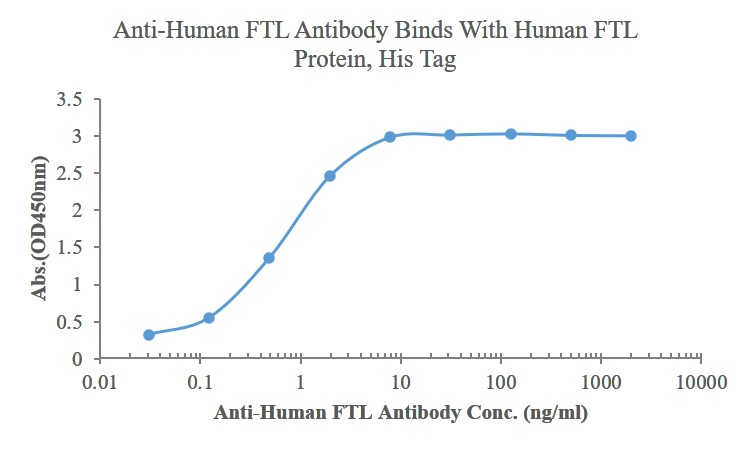| 產(chǎn)品編號(hào) | W2401 |
| 英文名稱 | Ferritin Light Chain |
| 中文名稱 | 鐵蛋白輕鏈抗體 |
| 別 名 | Ferritin light polypeptide; Ferritin L chain; Ferritin L subunit; Ferritin light chain; Ferritin light polypeptide like 3; FRIL; FRIL_HUMAN; FTL; L apoferritin; MGC71996; NBIA 3; NBIA3. |
| 理論分子量 | 20kDa |
| 細(xì)胞定位 | 細(xì)胞漿 細(xì)胞外基質(zhì) 分泌型蛋白 |
| 性 狀 | Liquid |
| 緩 沖 液 | 0.01M PBS(pH7.4) |
| 保存條件 | Shipped at 4℃. Store at -20 °C for one year. Avoid repeated freeze/thaw cycles. |
| 注意事項(xiàng) | This product as supplied is intended for research use only, not for use in human, therapeutic or diagnostic applications. |
| 產(chǎn)品介紹 | This gene encodes the light subunit of the ferritin protein. Ferritin is the major intracellular iron storage protein in prokaryotes and eukaryotes. It is composed of 24 subunits of the heavy and light ferritin chains. Variation in ferritin subunit composition may affect the rates of iron uptake and release in different tissues. A major function of ferritin is the storage of iron in a soluble and nontoxic state. Defects in this light chain ferritin gene are associated with several neurodegenerative diseases and hyperferritinemia-cataract syndrome. This gene has multiple pseudogenes. [provided by RefSeq, Jul 2008]. Function: Stores iron in a soluble, non-toxic, readily available form. Important for iron homeostasis. Iron is taken up in the ferrous form and deposited as ferric hydroxides after oxidation. Also plays a role in delivery of iron to cells. Mediates iron uptake in capsule cells of the developing kidney. Subunit: Oligomer of 24 subunits. There are two types of subunits: L (light) chain and H (heavy) chain. The major chain can be light or heavy, depending on the species and tissue type. The functional molecule forms a roughly spherical shell with a diameter of 12 nm and contains a central cavity into which the insoluble mineral iron core is deposited. Iron enters the spherical protein shell through pores that are formed between subunits. Mutations leading to truncation or the addition of extra residues at the C-terminus interfere with normal pore formation and with iron accumulation. DISEASE: Defects in FTL are the cause of hereditary hyperferritinemia-cataract syndrome (HHCS) [MIM:600886]. It is an autosomal dominant disease characterized by early-onset bilateral cataract. Affected patients have elevated level of circulating ferritin. HHCS is caused by mutations in the iron responsive element (IRE) of the FTL gene. Defects in FTL are the cause of neurodegeneration with brain iron accumulation type 3 (NBIA3) [MIM:606159]; also known as adult-onset basal ganglia disease. It is a movement disorder with heterogeneous presentations starting in the fourth to sixth decade. It is characterized by a variety of neurological signs including parkinsonism, ataxia, corticospinal signs, mild nonprogressive cognitive deficit and episodic psychosis. It is linked with decreased serum ferritin levels. Similarity: Belongs to the ferritin family. Contains 1 ferritin-like diiron domain. SWISS: P02792 Gene ID: 2512 Database links: Entrez Gene: 2512 Human Entrez Gene: 14325 Mouse Omim: 134790 Human SwissProt: P02792 Human SwissProt: P29391 Mouse Unigene: 433670 Human Unigene: 713706 Human Unigene: 30357 Mouse Unigene: 431913 Mouse Unigene: 1905 Rat |
| 產(chǎn)品圖片 | |
我要詢價(jià)
*聯(lián)系方式:
(可以是QQ、MSN、電子郵箱、電話等,您的聯(lián)系方式不會(huì)被公開)
*內(nèi)容:









